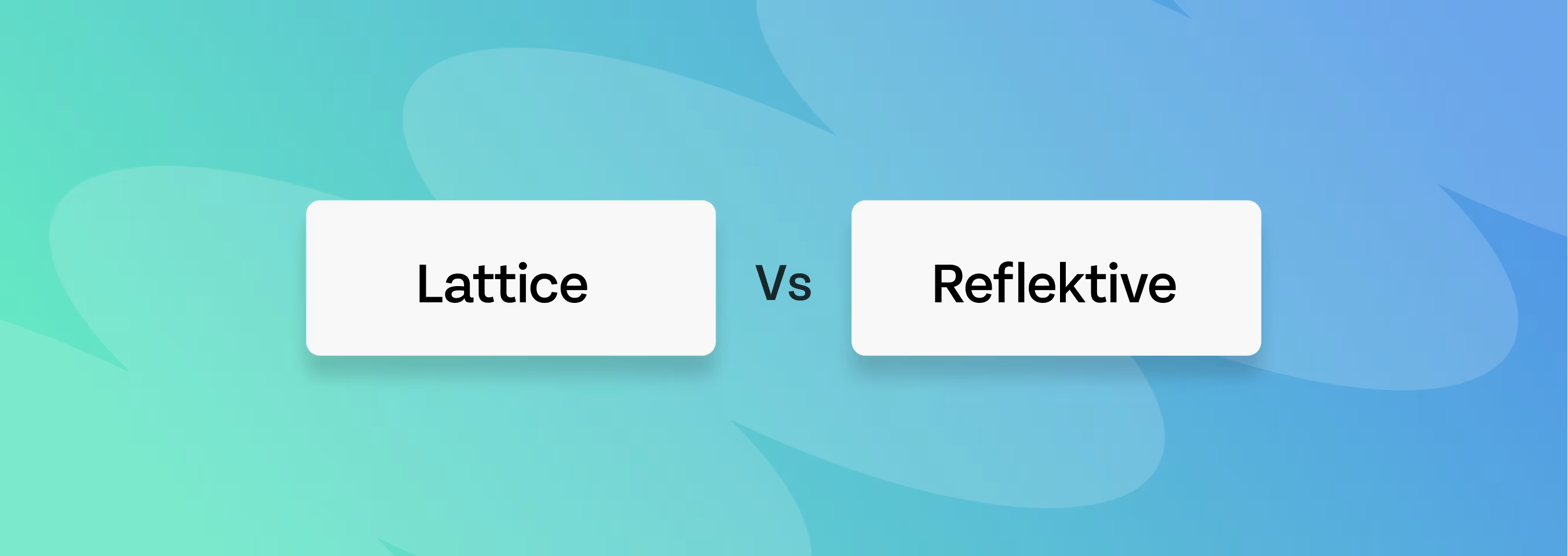If you're evaluating performance management platforms, you're likely dealing with ineffective annual reviews, fragmented feedback systems, or lack of meaningful goal alignment across your organization. Remote and hybrid work has made continuous performance management essential for maintaining productivity and engagement.
Lattice and Reflektive represent fundamentally different approaches to these challenges. In this blog we will explore what each platform delivers, true cost implications, and real user experiences from implementing organizations.
What Is Lattice?

Lattice has built what they call a comprehensive people management platform, designed to eliminate one of the biggest frustrations for growing organizations: managing multiple disconnected HR tools. Instead of juggling separate systems for performance reviews, goal tracking, feedback collection, and engagement surveys, Lattice integrates these functions into a unified platform.
This integration addresses a pain point that probably sounds familiar—when your performance data, goal progress, and feedback exist in separate systems, it becomes nearly impossible to see holistic employee development patterns or make informed decisions about talent development and organizational performance.
Lattice Features
Lattice's modular approach means you can start with what you need and expand as your organization grows. Here's what you're actually getting with each component:
1. Performance Reviews & Talent Reviews
You can design custom review workflows that fit how your organization actually operates, run multi-rater 360-degree feedback, and calibrate ratings across teams for consistency. The talent review tools include nine-box grids that help you map employee potential against current performance—particularly valuable for succession planning and identifying high-potential talent.
2. OKR-driven Goal Management
The goal-setting module is built around the Objectives and Key Results framework, which keeps strategic alignment front and center. Goals can be displayed directly in daily tools like Slack, Salesforce, and Jira, so they stay visible in the flow of work rather than buried in a separate platform. Mid-cycle adjustments are possible, which makes it well-suited for fast-changing business environments where priorities shift.
3. Engagement & Pulse Surveys
The platform includes engagement surveys with over 90 benchmarks, giving you context for your results rather than just raw numbers. AI-backed suggestions help you interpret data and identify action items. Pulse surveys and eNPS tracking allow your HR team to monitor sentiment continuously rather than waiting for annual surveys.
4. Real-time Feedback & 1:1 Meetings
Employees can provide feedback and suggestions for co-workers using either pre-built or custom templates. The structured 1:1 meeting templates, shared agendas, and follow-up notes are designed to make feedback frequent and meaningful rather than an afterthought.
5. Performance Improvement Plans (PIPs)
Lattice offers HR-approved PIP templates with approval workflows, employee acknowledgment processes, and progress tracking. This includes audit-ready documentation with approval logs and outcome histories—critical for legal compliance if situations escalate.
6. People Analytics & Lattice AI
The platform centralizes employee performance, demographic, and engagement data in comprehensive dashboards. The integrated AI tool helps managers write more effective reviews, extract insights from survey comments, and provides an always-on AI agent for HR support and retention risk flagging.
7. Employee Health & Turnover Risk Detection
Available when you're using both HRIS and Performance modules, Employee Health analyzes team stability, growth patterns, feedback trends, sentiment data, and tenure information to surface risk scores (high, medium, low) for potential turnover before it becomes reality.
8. Career Development & Growth Tools
The platform includes career pathing frameworks, Individual Development Plans (IDPs), skill assessments, and growth opportunity visualization to help employees see advancement paths within your organization—critical for retention.
9. Compensation Management
Compensation bands help ensure pay equity with transparent salary ranges, benchmarking capabilities, and streamlined compensation cycle management. Two-way approval visibility and automated workflows reduce the administrative burden of comp reviews.
10. HRIS & Administrative Functions
The optional HRIS module handles core HR tasks including employee records, onboarding workflows, time-off tracking, payroll integration, and customizable reporting with automated compliance features. Currently available in the US with beta availability elsewhere.
11. Advanced Analytics & Custom Roles
Features include Analytics Charts for data exploration, one-to-many custom roles for scaled access management, and comprehensive reporting with filters for demographics, departments, tenure, and performance trends.
Lattice G2 review
Average Score: 4.7/5 across review platforms
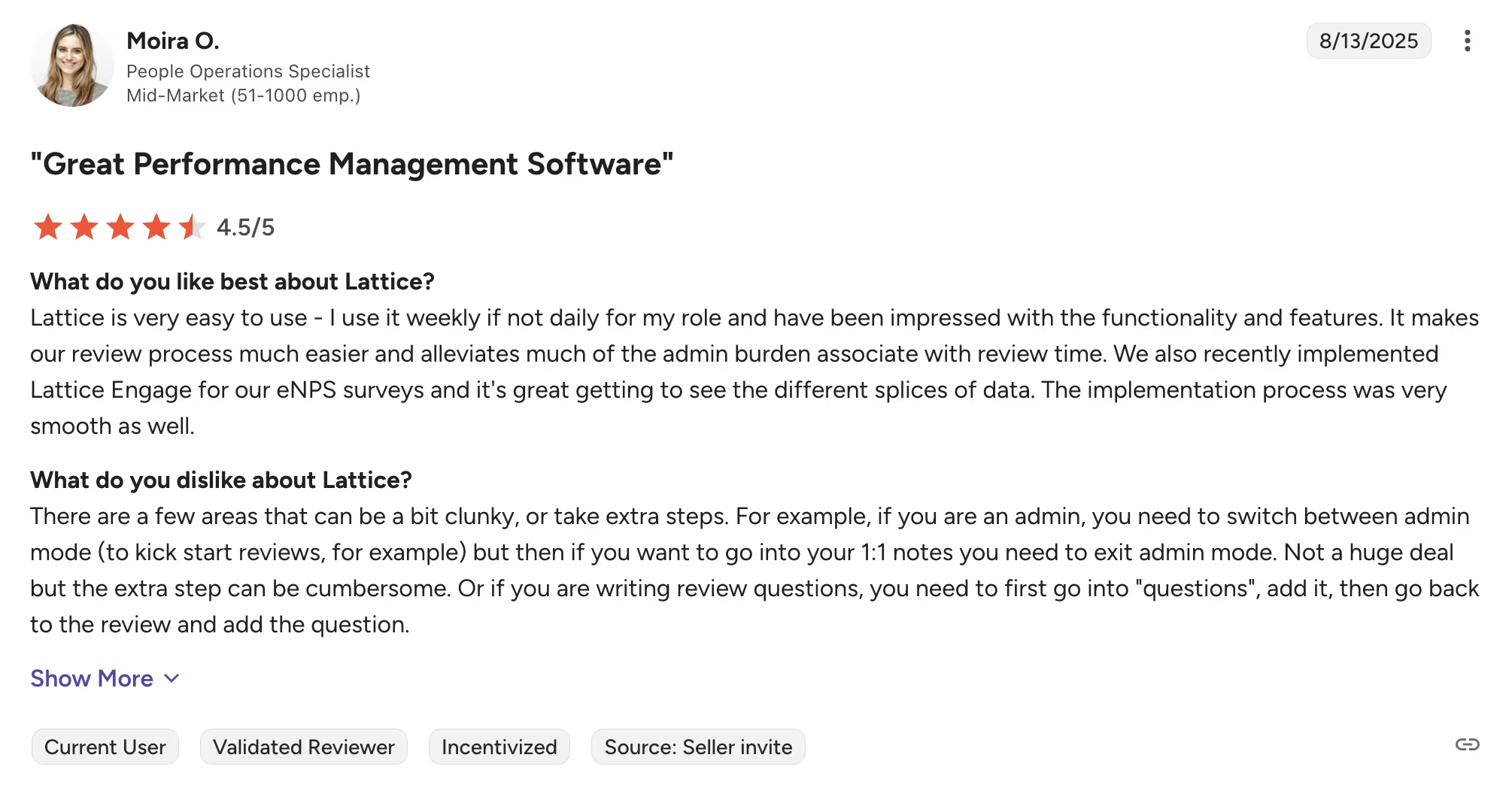
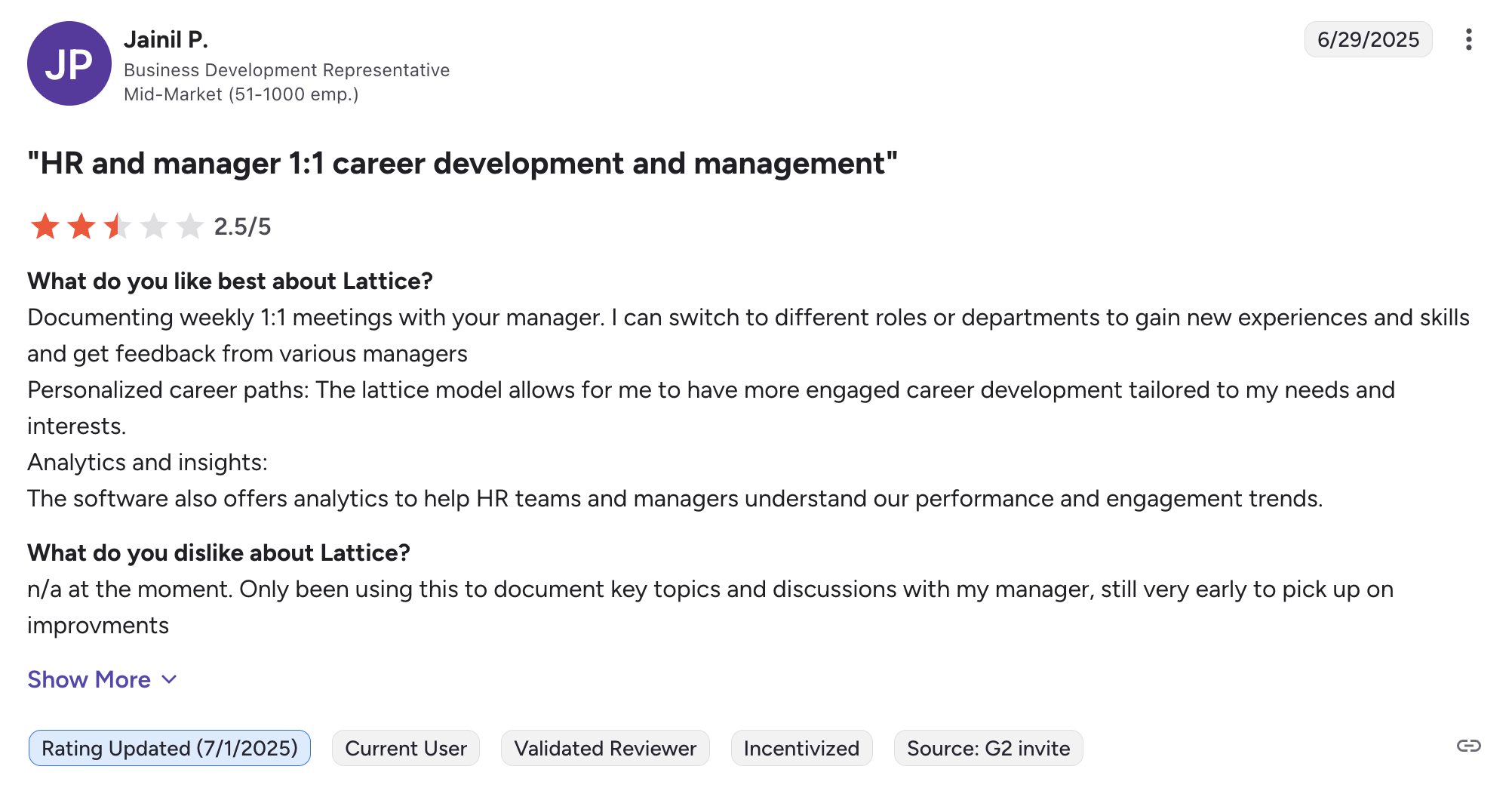
Lattice Pricing
Understanding Lattice's pricing structure is essential for budget planning, especially since their modular approach can scale significantly based on your organization's needs:
Core Platform Investment:
The foundation of Lattice starts with their Talent Management bundle at $11/user/month, which combines Performance and OKRs & Goals functionality. If you prefer to start smaller, you can purchase Performance only or OKRs & Goals only individually for $8/user/month each—though most organizations find the $3 premium for the bundle worth the integrated experience.
Strategic Add-on Modules:
Once you have the foundation, you can expand capabilities with add-on modules:
- Engagement: +$4/user/month for pulse surveys, eNPS tracking, and engagement analytics
- Grow: +$4/user/month for career development tools, competencies, and Individual Development Plans
- Compensation: +$6/user/month for compensation cycle management, benchmarking, and pay equity tools
- HRIS Core: $10/user/month for employee records, onboarding workflows, and administrative functions
Additional Functionality (U.S. Only):
- Payroll: +$6/user/month (integrates with HRIS for streamlined payroll management)
- Time Tracking: +$2/user/month for timesheets and payroll export capabilities
Financial Commitment Structure:
- Minimum annual spend: $4,000 across all modules and users
- Billing requirement: Annual contracts only (no monthly payment options)
- Implementation approach: No extra implementation fees for the core Performance product, though optional implementation packages are available for HRIS data transitions
Total Cost Planning:
A typical mid-sized organization using the full suite (Performance + Goals + Engagement + Grow + Compensation) would invest $25/user/month before HRIS functionality. Factor in the annual minimum when planning your rollout timeline—this structure works well for organizations with at least 15-20 employees who want comprehensive people management capabilities.
The modular approach allows you to start focused and expand strategically, but it's worth modeling different scenarios to understand how costs scale with your team growth and feature adoption plans.
Lattice Ideal Customers
- Mid-sized to large organizations (100+ employees) with dedicated HR resources
- Companies prioritizing data-driven people management decisions
- Organizations willing to invest in implementation and change management
- Teams requiring customizable workflows and comprehensive analytics capabilities
Lattice Pros:
- Clean, intuitive interface that actually gets adopted—managers don't need training sessions to figure out basic navigation [People Managing People]
- Robust analytics and reporting that help you make talent decisions based on data rather than gut feelings [People Managing People]
- Strong continuous feedback culture with goal alignment that encourages ongoing performance conversations instead of dreaded annual reviews [Research.com]
Lattice Cons:
- Customization limitations in review templates and survey workflows—if your organization has highly specific processes, you might find yourself adapting to Lattice rather than the other way around [People Managing People]
- Integration headaches, particularly with Outlook calendar sync, which creates real friction when trying to schedule 1:1s and check-ins [Software Advice]
- Steep learning curve and setup complexity that can overwhelm smaller teams without dedicated HR resources—it's powerful, but you'll need to invest time to learn it [Research.com]
Lattice Customer Reviews
Market Position and Adoption:
Lattice reports over 5,000 teams using their platform, which indicates significant market adoption. Notable implementations include companies like Faire and Linktree using their individual development planning features [Source: lattice].
Measurable Business Impact:
Customer case studies show tangible results: Weave reports saving 30 hours per engagement survey cycle, while USAirtours attributes a 20% sales increase to improved performance management processes [Source: lattice Customer stories].
Implementation Reality Check:
User feedback consistently emphasizes the platform's comprehensive capabilities while noting that organizations need dedicated resources for setup and ongoing management to realize full value. This isn't a "set it and forget it" solution.
What Is Reflektive?
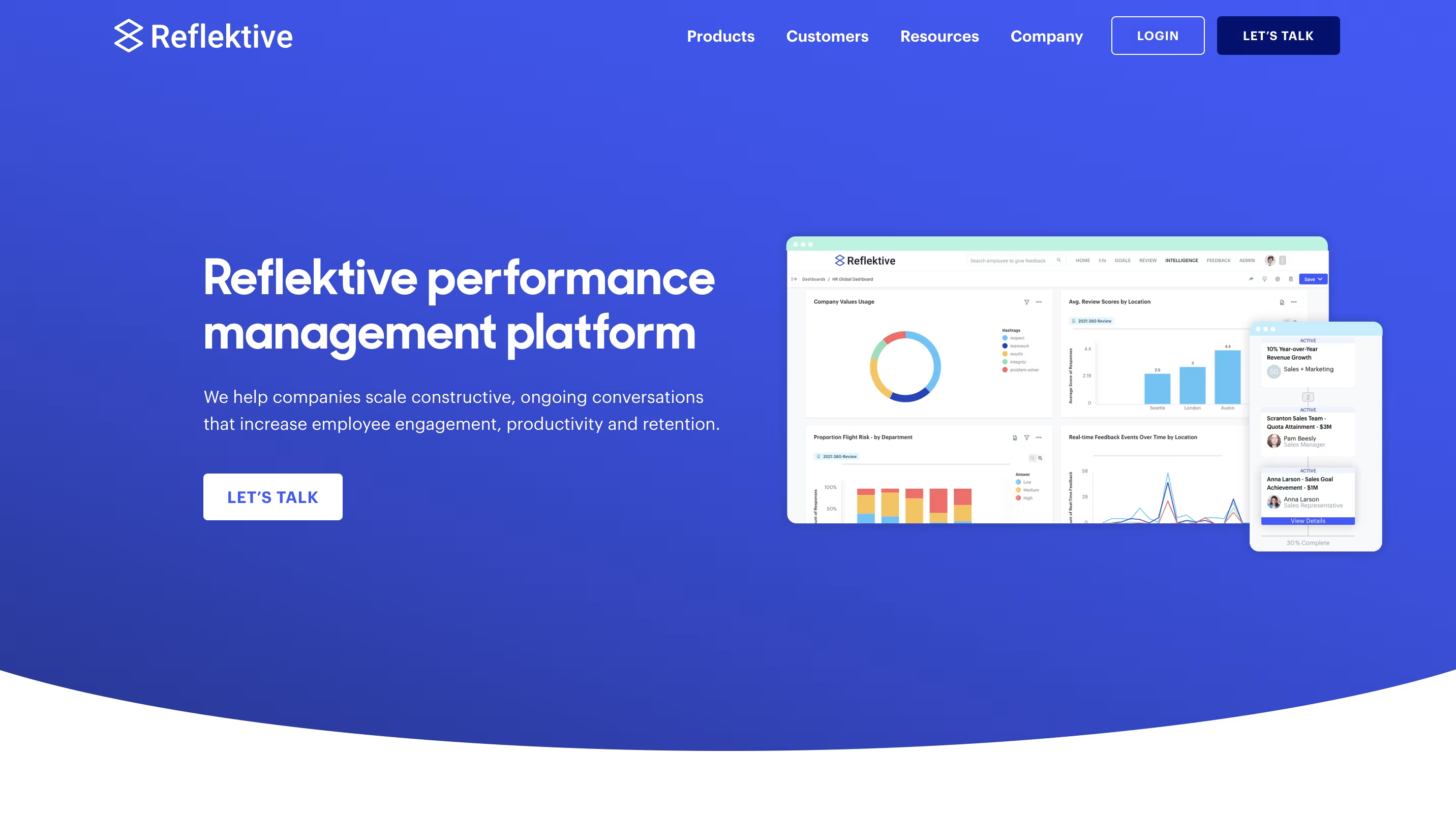
Reflektive takes a fundamentally different approach to performance management, focusing specifically on continuous feedback and recognition rather than trying to be a comprehensive people management solution. The platform is built around the principle that performance conversations should integrate seamlessly into existing work patterns rather than requiring separate, formal processes.
This approach appeals to organizations that prefer operational simplicity and want to avoid the complexity often associated with comprehensive HR platforms.
Reflektive Features
1. Real-time Feedback Infrastructure
Reflektive enables immediate feedback delivery through email, Slack, or Teams integration, eliminating the need to access separate platforms. Recognition capabilities allow for immediate acknowledgment of achievements and contributions—which research shows is more effective than delayed recognition.
2. Goal Management Framework
The platform supports individual, team, and company-level goal setting with basic progress tracking and OKR format compatibility. It's not as visually rich as dedicated OKR tools, but it covers the fundamentals.
3. Performance Review Process
Structured review workflows include 360-degree feedback capabilities, one-on-one meeting templates, and performance check-in frameworks designed to improve the quality of manager-employee conversations.
4. Employee Engagement Monitoring
Basic pulse survey functionality and sentiment tracking provide insights into team engagement without creating survey fatigue—a common problem with more comprehensive platforms.
5. Operational Analytics
The platform supports integrated analytics for reviews, check-ins, goals, feedback, and surveys Reflektive, focusing on operational metrics rather than strategic workforce analytics.
Reflektive G2 review
Average Score: 4.2/5 across review platforms
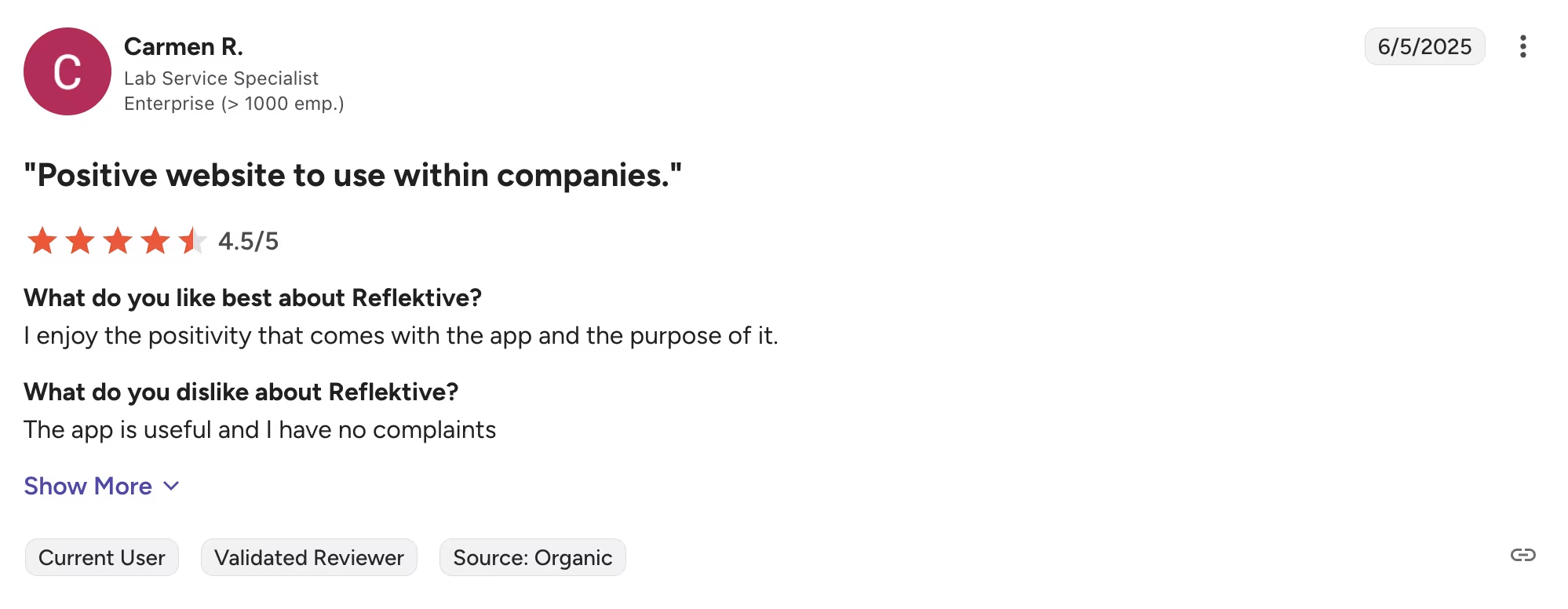
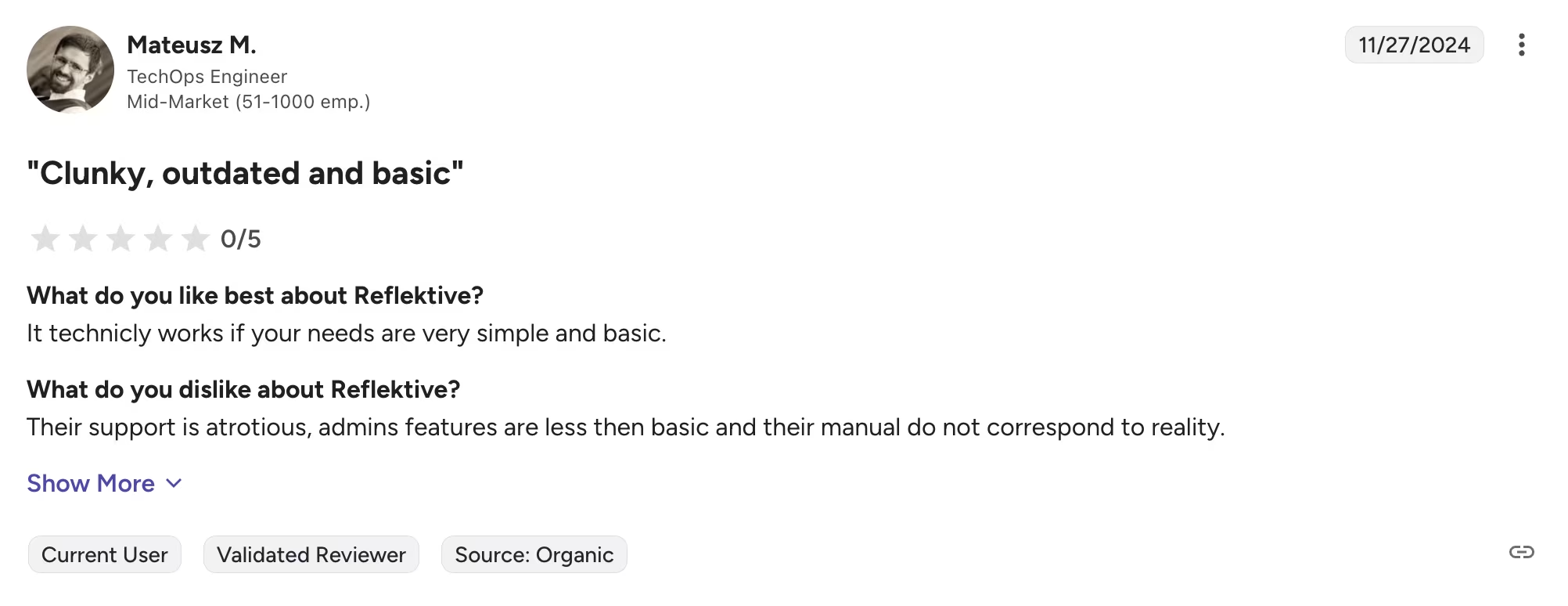
Reflektive Pricing
The Pricing Reality:
Reflektive operates on a quote-based, flat-rate pricing model that can be frustrating if you're trying to do quick budget comparisons. According to Capterra, their "Basic" plan is listed at $7,500/month (flat rate) , though this appears to be for larger implementations rather than smaller teams.
What This Means for Your Budget:
- No free tier or public trial available
- You'll need to engage with their sales team to get tailored pricing
- Budget planning requires going through their sales process, which can slow down procurement timelines
The lack of transparent pricing typically indicates either premium positioning or significant pricing variation based on customer size and requirements. [Source: Capterra].
Reflektive Ideal Customers
Where Reflektive Fits Best:
- Teams that prioritize simplicity and usability over comprehensive feature sets
- Organizations already heavily integrated with Slack, Teams, or email workflows—Reflektive supports feedback within these existing channels
- Companies where speedy onboarding and lower friction are more valuable than extensive customization options
- Teams that prefer focused functionality over broad people management capabilities
Reflektive Pros:
- User-friendly interface that doesn't overwhelm managers with complex features
- Quick implementation with minimal setup and training requirements
- Strong integration with communication tools teams already use daily
- Focused approach that emphasizes continuous conversations over formal processes
Reflektive Cons:
- Flat-rate pricing model may offer less flexibility and could be expensive for smaller organizations
- Opaque pricing requires sales negotiations and makes budget planning more complex
- User engagement challenges require ongoing management to maintain consistent platform utilization G2
- Limited comprehensive functionality compared to full people management platforms
Reflektive Customer Reviews
What Users Actually Say:
The Positive Feedback:
"Reflektive is really user friendly … it's not clunky … the reporting feature is also really useful" [Source: G2].
Users consistently praise the platform's simplicity and straightforward approach to performance management.
The Engagement Challenge:
"People often forget about it — we have to really remind people … get people to remember to log in … because it feels like an extra step" [Source: G2].
This feedback suggests that while Reflektive is easy to use, maintaining consistent user engagement requires ongoing management attention.
The Alternative Worth Considering: ThriveSparrow
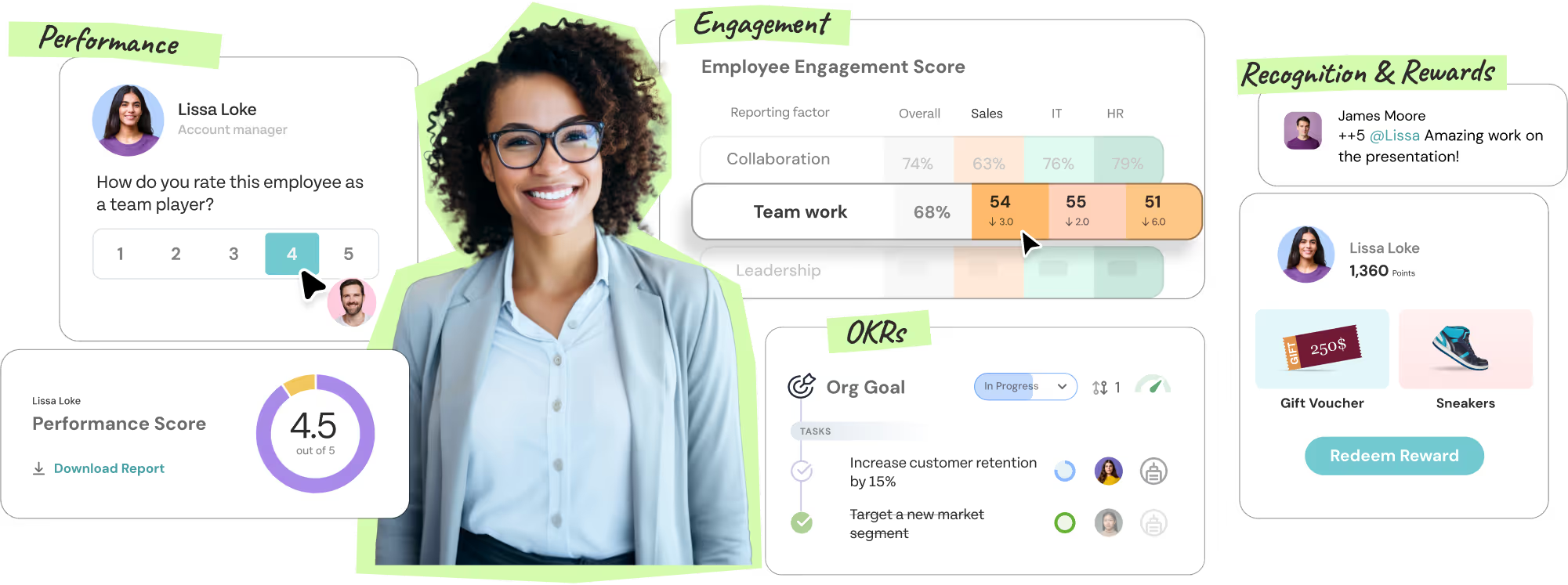
Before making your final decision, there's another platform worth exploring: ThriveSparrow. It's gaining attention among HR teams who want robust performance management capabilities without the typical implementation challenges or budget surprises that come with enterprise platforms.
Here's what makes ThriveSparrow different: it delivers comprehensive functionality with the kind of user experience that actually gets adopted across your organization. While Lattice requires significant setup and Reflektive struggles with engagement, ThriveSparrow bridges these gaps by offering:
1. Comprehensive Without the Complexity
You get full performance management capabilities—reviews, goals, recognition, engagement surveys, and analytics—without the months-long implementation projects that enterprise tools demand.
2. Transparent Pricing That Makes Sense
No hidden fees, no surprise costs when you want basic features, and no annual minimums that lock you into bad decisions. You'll know exactly what you're paying before you even talk to sales.
3. Quick Deployment, Real Results
Implementation measured in weeks, not months, so your team can start seeing improvements while competitors are still configuring their platforms.
4. Analytics That Don't Require Technical Skills
Powerful insights and reporting that help you make strategic decisions without needing a dedicated data science team to interpret the results.
5. Support That Actually Supports
Customer service designed for growing organizations rather than enterprise bureaucracy—when you have questions, you talk to people who understand performance management.
Which Platform Is Right for You?
Choose Lattice When:
- You want the whole performance management ecosystem under one roof—performance reviews, goals, engagement surveys, and compensation management all working together
- Your HR team has the bandwidth and expertise to handle setup, configuration, and ongoing platform management (this isn't a weekend project)
- Advanced analytics and workforce insights are crucial for your strategic planning—you need data to drive decisions, not just gut feelings
- You can comfortably meet their $4,000 minimum annual commitment and are fine with annual billing cycles
- You're planning to grow into the platform's full capabilities and see the initial complexity as an investment in long-term functionality
Choose Reflektive When:
- Continuous feedback, recognition, and straightforward goal tracking are your main objectives rather than comprehensive people management
- You prefer a streamlined, focused system over an all-in-one solution that might feel overwhelming
- You're comfortable navigating custom pricing negotiations (think ~$7,500/month flat rate as Capterra suggests) without transparent published rates Capterra
- Getting up and running quickly matters more to you than having extensive feature depth
- Basic reporting meets your current needs, and you're okay supplementing with other analytics tools if necessary
Consider ThriveSparrow When:
- You want comprehensive performance management features without the enterprise-level setup headaches that typically come with them
- Transparent pricing is non-negotiable—you want to know what you'll pay before getting into sales conversations
- You need rapid deployment but still want meaningful analytics and strategic insights, not just operational reporting
- You value responsive, human customer support over the typical enterprise software experience where you're just another ticket number
Finnal Thoughts
Choosing between Lattice and Reflektive comes down to what you can actually handle right now. Lattice gives you everything but demands serious commitment—time, resources, and patience for setup. Reflektive keeps things simple but might leave you wanting more as you grow.
Here's the thing though: platforms like ThriveSparrow are proving you don't have to accept these trade-offs anymore. Why choose between comprehensive features and easy implementation when you could have both?
The best performance management platform isn't the one with the most impressive demo or the longest feature list—it's the one your team will actually use consistently to have better conversations about performance and growth.
What's really driving your search? If you want comprehensive functionality without the complexity headaches, it might be worth seeing what ThriveSparrow offers before settling for traditional limitations.
Try ThriveSparrow free for 14 days!!!
FAQs
1. How much does Lattice actually cost compared to Reflektive?
Lattice starts at $11/user/month for core features but can reach $25+/user/month with add-ons, plus a $4,000 annual minimum. Reflektive uses custom quotes with reported flat rates around $7,500/month but no public pricing. Total cost depends on team size and needs—Lattice may be cheaper for smaller teams, Reflektive potentially better for larger organizations.
2. Which platform is easier to implement and use?
Reflektive is simpler to set up and use, but users report having to constantly remind people to engage with it. Lattice requires more complex implementation and dedicated HR resources but tends to have stronger adoption once properly set up. Choose Reflektive for immediate simplicity, Lattice if you can invest in proper implementation.
3. Do Lattice and Reflektive integrate well with existing tools?
Lattice offers broader integration with HRIS systems, Slack, Teams, Salesforce, and Jira, though users report Outlook calendar sync issues. Reflektive focuses on communication tools (email, Slack, Teams) for feedback delivery but has limited HRIS integration. Lattice is stronger for comprehensive system integration, Reflektive better for communication-based feedback.
4. Which platform provides better analytics and reporting?
Lattice clearly leads with AI-powered insights, turnover risk detection, custom dashboards, and strategic workforce analytics. Reflektive offers basic operational metrics focused on feedback completion and engagement tracking. Choose Lattice if analytics drive your HR strategy, Reflektive if you need simple feedback activity reporting.
5. Are there better alternatives to Lattice and Reflektive?
Yes, platforms like ThriveSpparrow combine comprehensive functionality with operational simplicity, eliminating traditional trade-offs. While Lattice requires complex setup and Reflektive has engagement challenges, newer solutions offer enterprise features with transparent pricing and rapid deployment. Consider alternatives that provide both power and practicality without compromise.













